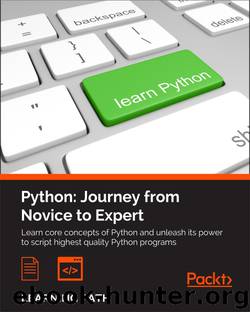Python: Journey from Novice to Expert by Fabrizio Romano

Author:Fabrizio Romano
Language: eng
Format: epub
Publisher: Packt Publishing
File I/O
Our examples so far that touch the filesystem have operated entirely on text files without much thought to what is going on under the hood. Operating systems, however, actually represent files as a sequence of bytes, not text. We'll do a deep dive into the relationship between bytes and text in Chapter 8, Strings and Serialization. For now, be aware that reading textual data from a file is a fairly involved process. Python, especially Python 3, takes care of most of this work for us behind the scenes. Aren't we lucky?
The concept of files has been around since long before anyone coined the term object-oriented programming. However, Python has wrapped the interface that operating systems provide in a sweet abstraction that allows us to work with file (or file-like, vis-á-vis duck typing) objects.
The open() built-in function is used to open a file and return a file object. For reading text from a file, we only need to pass the name of the file into the function. The file will be opened for reading, and the bytes will be converted to text using the platform default encoding.
Of course, we don't always want to read files; often we want to write data to them! To open a file for writing, we need to pass a mode argument as the second positional argument, with a value of "w":
contents = "Some file contents" file = open("filename", "w") file.write(contents) file.close()
Download
This site does not store any files on its server. We only index and link to content provided by other sites. Please contact the content providers to delete copyright contents if any and email us, we'll remove relevant links or contents immediately.
Deep Learning with Python by François Chollet(12957)
Hello! Python by Anthony Briggs(10198)
The Mikado Method by Ola Ellnestam Daniel Brolund(10107)
OCA Java SE 8 Programmer I Certification Guide by Mala Gupta(10043)
Dependency Injection in .NET by Mark Seemann(9581)
Algorithms of the Intelligent Web by Haralambos Marmanis;Dmitry Babenko(8588)
Grails in Action by Glen Smith Peter Ledbrook(7942)
Becoming a Dynamics 365 Finance and Supply Chain Solution Architect by Brent Dawson(7903)
Test-Driven iOS Development with Swift 4 by Dominik Hauser(7900)
The Well-Grounded Java Developer by Benjamin J. Evans Martijn Verburg(7842)
Microservices with Go by Alexander Shuiskov(7669)
Practical Design Patterns for Java Developers by Miroslav Wengner(7567)
Test Automation Engineering Handbook by Manikandan Sambamurthy(7502)
Angular Projects - Third Edition by Aristeidis Bampakos(6978)
Secrets of the JavaScript Ninja by John Resig Bear Bibeault(6739)
The Art of Crafting User Stories by The Art of Crafting User Stories(6433)
NetSuite for Consultants - Second Edition by Peter Ries(6381)
Demystifying Cryptography with OpenSSL 3.0 by Alexei Khlebnikov(6178)
Kotlin in Action by Dmitry Jemerov(5369)
